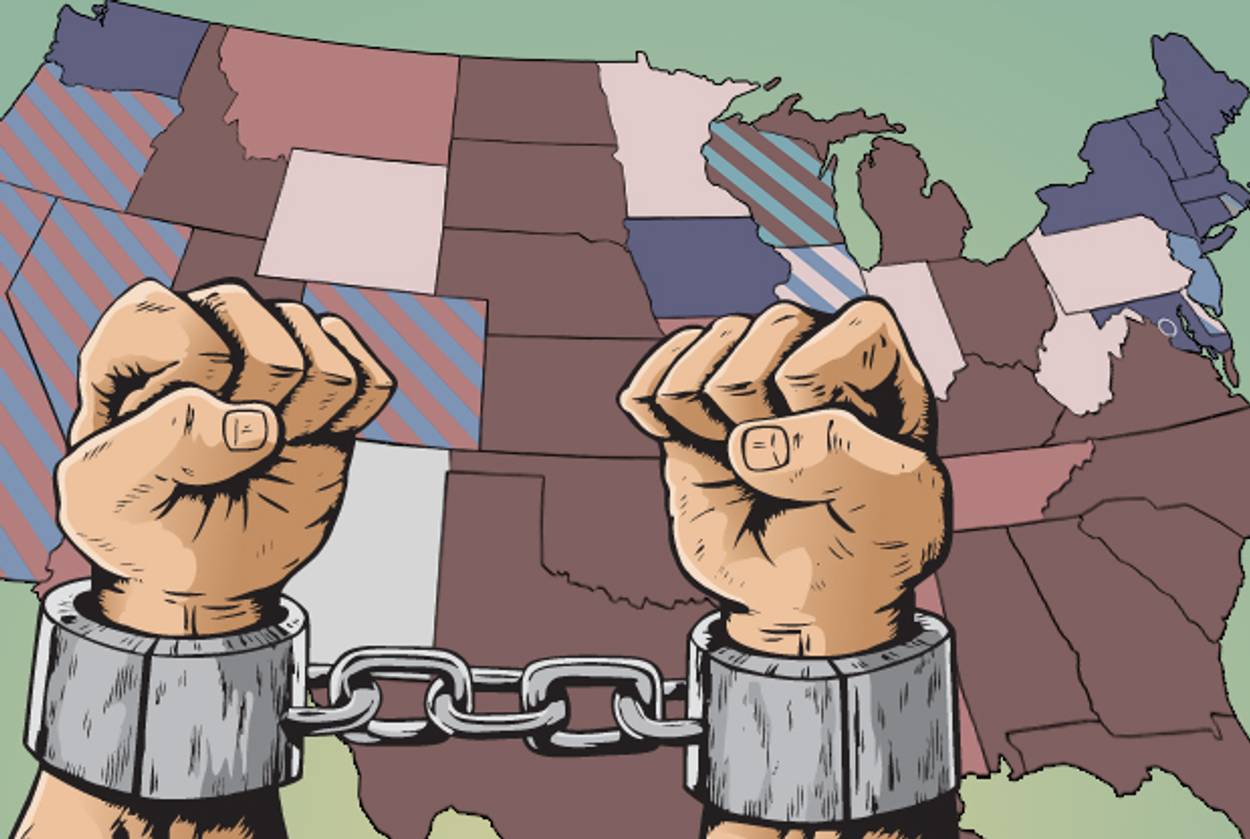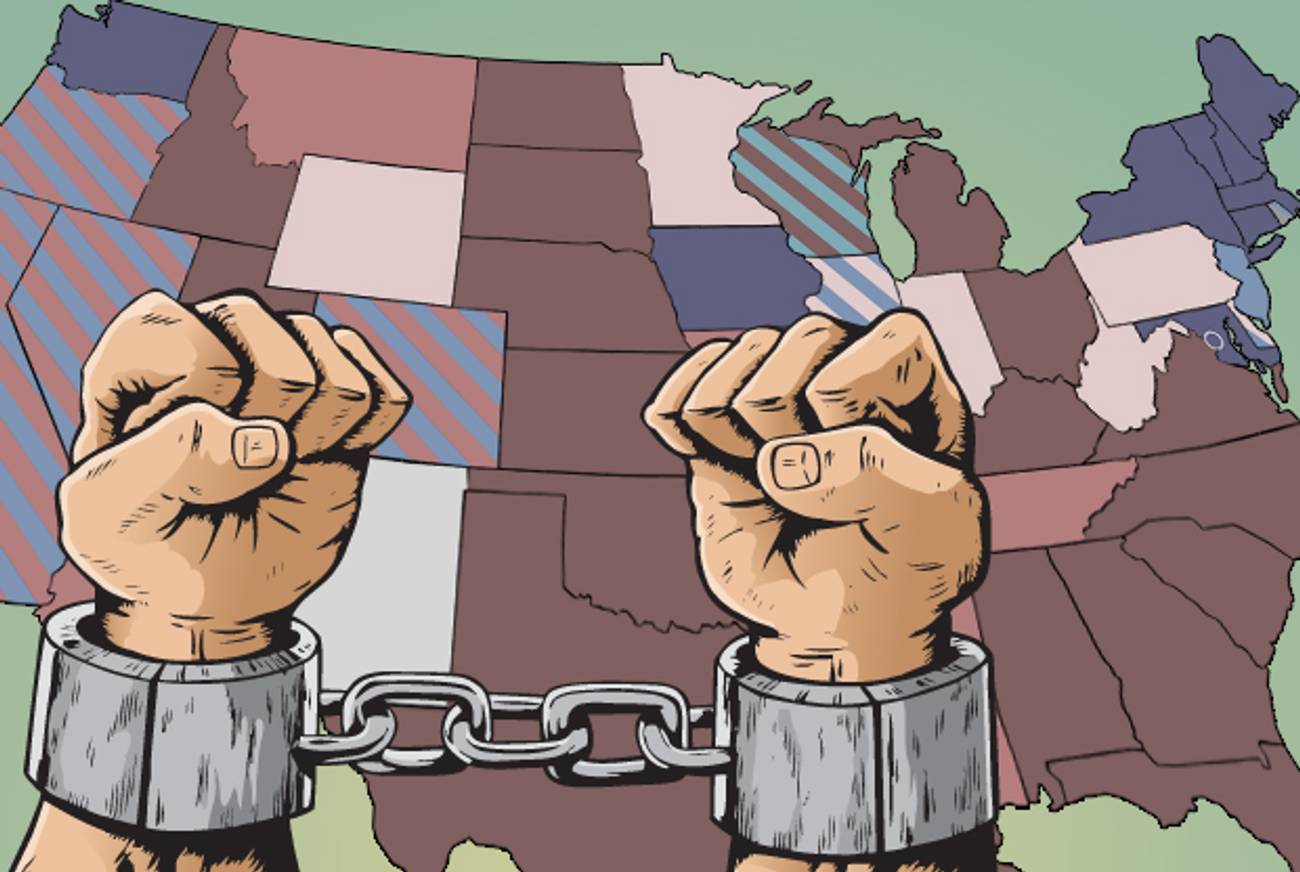A Chained Man
Thanks to the patchwork of laws about same-sex marriage, I got trapped in legal limbo when I wanted a divorce




Last week, the Supreme Court heard testimony in two cases that may decide the future of same-sex marriage in the United States. But personally, I’ve been more concerned lately with same-sex divorce.
I got divorced in February. Or, since I was never technically married as far as the federal government is concerned, maybe I should say I got a dissolution. Or a disunion. Whatever you call it, a relationship that began with lively gaiety under the chuppah but had long since become a moribund afterthought reached its legal end, releasing me definitively and finally from any remaining force of my vows.
Divorce isn’t unusual in itself. But in my case, because we were a same-sex couple, it had taken nearly 11 years from the time we ended the relationship until we could make it official. For more than a decade, I had been not-quite-married and not-quite-divorced, chained to a man I could not free myself from.
***
Just after I came out as gay to myself, my family, and my friends at the start of 2000, I met a nice Jewish boy at synagogue, of all places. He and I were in our late 20s and had grown up in the Philadelphia suburbs not far from each other. Our relationship was “mixed” insofar as he was from a Reform background and I was Conservative, but Judaism and Jewish community were important to both of us. Given this background and where we found each other, it was no surprise that our religious and cultural values and traditions played a significant part in how our time together unfolded.
About a year and a half after we started dating, the two of us entered into a civil union—also known derisively as marriage lite. Although our home state of Pennsylvania denied us all matrimonial rights, as it continues to do for all same-sex couples today, Vermont had no residency requirements for civil unions—which, at that point, were the closest thing to marriage available to gay couples in any state. Making effective use of a long weekend, we drove up one fall Friday, got our license that afternoon, stood under the chuppah before a rabbi on Sunday evening, and returned to Philadelphia on Monday.
Our honeymoon period was short, though, and before long, our relationship fell apart, for many of the same reasons that heterosexuals’ so-called “starter marriages” fail. But exiting it was much trickier for us. As easy as Vermont made getting kind-of-hitched for out-of-staters, decoupling was another story: The state’s statutes required six months’ residency before courts were permitted even to entertain a request to break up a civil union. The progressive folks in Montpelier who had helped us say “I do” gave us little assistance in saying “I don’t anymore.”
Opposite-sex couples have an easy solution when they can’t terminate their marriage where they were joined: They divorce where they live. Had we been straight, we could have filed in Pennsylvania, just like 38,479 heterosexual couples did that year, regardless of where they had gotten married. But Pennsylvania couldn’t help us dissolve a union it never recognized in the first place.
The United States is a patchwork of different jurisdictions with divergent juridical stances on dissolving same-sex relationships, even today. In Massachusetts, for example, where same-sex marriage has been legal since 2004, either partner can seek a divorce, just as their straight counterparts can; some other states, including a smattering without marriage equality, lay out a dissolution route through a petition or action-based mechanism. Elsewhere, gay and lesbian spouses garner no state-sanctioned recognition, and no governmental organ can put the two asunder because, as far as local law is concerned, there’s nothing to undo. Meanwhile, the Defense of Marriage Act, enacted by Congress in 1996, currently precludes the federal government from acknowledging same-sex marriages or providing any of the benefits that flow from them, even if such marriages are recognized by the state in which the couple resides.
For these reasons, when I queried lawyers familiar with this area of law, they urged caution in entering the legal arena: Outcomes in cases like ours depend in significant part on what kind of affiliation the couple entered into, where they reside, and the interpretations of the judge they stand before. If Oregon recognizes civil unions but constitutionally bans same-sex marriage, how does it treat two men married halfway across the country in Iowa? What do Iowa magistrates do with Oregon civil unions, which have never been a part of Iowa law? How do Nevada’s “domestic partnerships” fit into this mix? And just as significantly, how many people in any one of these positions, already enduring the “ordinary” trauma of splitting up, want to be a test case if their state’s stance is unclear?
As cardboard boxes swallowed our ketubah, our photographs, and other flotsam and jetsam from better days, nothing inspired me to strike out as a queer pioneer-missionary, conquering new territories for civil rights and converting a hetero-normative judiciary into educated rainbow-flag-waving allies; all I wanted was to get this voyage over with as definitely, as safely, and as speedily as possible. But moving to Vermont wasn’t a realistic option, and we couldn’t resolve anything in Pennsylvania, so we simply and anticlimactically walked away, somewhat locked into something like wedlock.
Even though a rabbi had performed our ceremony, seeking a religious release from our bonds presented obstacles. In recent years, several Jewish movements and institutions have attempted to keep pace with the growing number of same-sex religious unions, including the ones that fail to survive, regardless of what a given legal system permits or denies. The Reconstructionist Rabbinical Association provides divorce rituals for two women, for two men, and for just one of the partners. Similarly, Rabbi Margaret Moers Wenig, a professor at North America’s flagship Reform seminary, has publicly shared her own experiences with same-sex separation and her own document for a same-sex ritual of spiritual and religious release. But as helpful as these rituals are from a spiritual perspective, they are of little assistance in persuading secular legal authorities in inhospitable jurisdictions, and 10 years ago, they were, at best, limited in their availability. The upshot was that both legally and religiously, we were stuck in our civil union.
We didn’t see or speak to each other for about a decade, but a definitive conclusion was elusive. Although this lingering connection didn’t loom large in my day-to-day life, I remained cognizant of its unresolvedness. Whether on opinion surveys, in dating questionnaires, or through casual queries, “What’s your marital status?” or some variation is supposed to be answerable through a series of familiar checkboxes (“Single/Married/Separated/Divorced/Widowed”). My indeterminate circumstances turned these mutually exclusive options into an essay. If I don’t expect to have further contact with my significant other, is “separated” fitting or misleading? Is “divorced” a better approximation? Because we had a “civil union,” not a “marriage,” could I be either? Was I “single”? Why not cross everything out and write “none of the above”? Without convincing and comfortable responses, I found myself with a standing both unfamiliar and unnameable, even to me.
I found the most analogous situation toward the more observant end of Judaism. Under traditional Jewish law, a husband, and only a husband, can grant a religious divorce or get; his wife must consent to the marriage’s termination but is legally incapable of initiating a repudiation of their bond. While a religious court can employ certain prodding measures, if the husband chooses not to issue a get, is unavailable, or cannot be located, his wife is bound to him, unable to remarry in a Jewish ceremony. These women, called agunot or “chained ones,” are sufficiently numerous and oppressed that organizations in Israel and throughout the Jewish world have sprouted to sustain them. Each agunah has her unique plight, but all share a common inability to religiously divorce the men they have married and to whom they are anchored.
My predicament was in no way as extreme as an agunah’s, and my travails were trivial compared to what agunot endure for months, years, or decades. I butted up against no adverse consequences in my communities, and I lacked no means of economic or other support. I was not extorted, intimidated, shamed, or shunned as a prelude to divorce; I was simply unable to get one.
And yet, even with the experiential gaps that stood between agunot and me, we lived in a shared limbo, chained indefinitely to a partner we no longer shared our lives with in practical terms, but unable to move forward.
***
Years passed. I dated off and on, but struggled with how to share my complicated background. My general practice was to avoid conversations about this part of my past as best as possible, lest I feel compelled to provide long stretches of explanatory context (or to at least try). For better or for worse, at no point did a relationship develop to the degree where I was comfortable doing so or where it seemed necessary.
Meanwhile, the rest of my life continued. I left Philadelphia, went from practicing law to matriculating at rabbinical school, studied in Israel, lived in New York City, and finally returned to Pennsylvania. But as far as I went, as far as the chain stretched, I stayed tethered to a part of my past and to someone whose whereabouts and circumstances were unknown to me.
This past July, my ex and I were in contact for the first time in nine years. He had moved to California, he said, and wanted to take advantage of laws there to officially end what remained of our relationship. I agreed, and we moved along amicably. Our court docket reflected my own labeling ambivalence, referring to our cause of action as a “Petition for Dissolution – Domestic Partnership” that concluded with a “Judgment for Dissolution of Marriage.” This lexical equivocation aside, any lingering legal linkage between us lapsed this year on Feb. 2, the date when the court order decreed our “marital status ends”; indifferent to Punxsutawney Phil’s prognostication, I left Groundhog Day 2013 with this particular shadow slightly shorter.
I’ve spent the past several months meandering from anxiety to sadness to relief to gratitude, revisiting stray memories and walking toward closure. I can’t say exactly what, at this late point, we’ve wrapped up, and I’m not sure if I’m divorced, single, “civilly disunited,” or something else. But among my certainties is this: I look forward to a day when religious and secular shackles are broken, freeing agunim and agunot of all kinds to move on with their lives.
***
Like this article? Sign up for our Daily Digest to get Tablet Magazine’s new content in your inbox each morning.
Seth Goren is the City Director of Repair the World: Philadelphia.
Seth Goren is the City Director of Repair the World: Philadelphia.